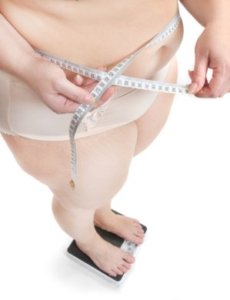Weight loss that works and is permanet
BMI and waist circumference. Are you overweight or TOFI (thin outside fat inside)?
 It is a myth that the only way to obtain or maintain your ideal weight is to stick with boring, low-fat diets and loads of hardcore physical training.
It is a myth that the only way to obtain or maintain your ideal weight is to stick with boring, low-fat diets and loads of hardcore physical training.
The following guide will help you adjust your own diet and exercise program – so that you can see permanent results. First, let’s look at your BMI and waist circumference, as many people have a somewhat distorted picture of their own weight and appearance.
Measure your own BMI and learn how to decipher it.
BMI (Body Mass Index) is a method for measuring the relation between height and weight. The method is not relevant before you are fully developed.
BMI is expressed in numbers:
- Lower than 20 – underweight
- 20-25 – normal weight
- 26-30 – overweight
- 30+ - obese
BMI is your weight (in kilograms) over your height squared (in centimeters)
The BMI for a person, who weighs 75 kilos and measures 1.65 meters, is: 75: (1.65 x 1.65) = 27.6
According to this measuring method, the person should ideally lose seven kilos or more – but it is only an indication
A BMI measurement is not enough
BMI does not provide any useful information about bone structure or the relation between muscle and fat tissue, which is highly important for your figure and health in general.
A person with heavy bones or large muscle mass may be just fine in terms of body fat, even with a BMI that is above 25. This is because bone and muscle weigh more than fat tissue.
Conversely, a person with small bones may have too much body fat, even with a BMI reading that is within the normal range. Such individuals are named TOFIs (thin outside fat inside) because there is an imbalance between weight, muscle mass, and fat mass.
It is therefore important to go further by using a measuring tape to see if your weight and figure correspond.
What is the correct waistline measurement – and what does it mean to your health?
Abdominal fat is the most harmful type of fat.
Therefore, people with apple-shaped figures are most likely to have problems with their blood sugar levels, and they also have an increased risk of type 2 diabetes and other lifestyle diseases. This is the case for both those who weigh too much and are normal weight and for those with large waistlines.
How to measure and test your waistline
- Stand with a relaxed posture and measure your waistline about two centimeters above your navel.
- Alternatively, wrap a tape measure around your abdomen, just above the top of the hipbones. Make sure the tape measure is even and level all the way around your waist. Gently tighten the tape measure so it fits snugly around your stomach.
- A woman’s waistline should ideally be less than 80 cm, while a man’s should not exceed 94 centimeters.
| The chart shows the relation between waistline circumference and the risk of lifestyle diseases | ||
| Slightly increased risk | Increased risk | |
| Men | Above 94 cm | Above 102 cm |
| Women | Above 80 cm | Above 88 cm |
Don’t forget that height and body structure also mean a lot, and that the above listed is only indicative
If you have problems with your weight and waistline circumference, it may be a good idea to identify the underlying cause(s) and take relevant action
- Created on .












 "After about one week of taking the Q10 supplement I could feel a huge difference," says 23-year old Alan Piccini, who has been suffering from extreme fatigue and muscle aches ever since he was a child.
"After about one week of taking the Q10 supplement I could feel a huge difference," says 23-year old Alan Piccini, who has been suffering from extreme fatigue and muscle aches ever since he was a child. “Taking capsules with co-enzyme Q10 has freed me of the severe side effects of my cholesterol lowering medicine,” Mrs Franken explains.
“Taking capsules with co-enzyme Q10 has freed me of the severe side effects of my cholesterol lowering medicine,” Mrs Franken explains.